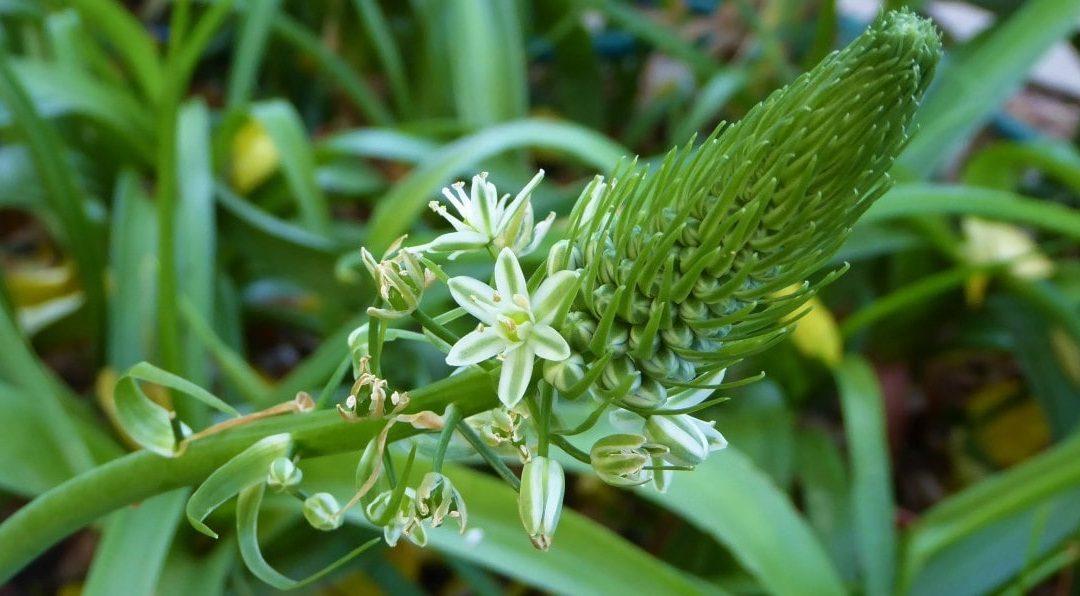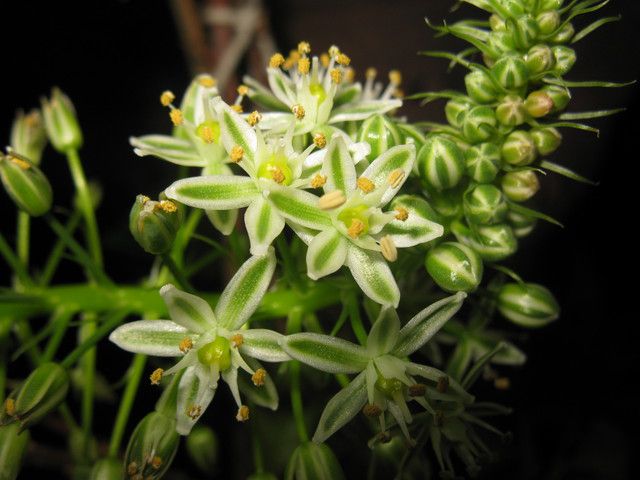All indoor bulbous plants are unique. And if you are tired of the beauty of familiar species that have become a kind of seasonal classic, you can always find outlandish, special exotic crops.
Among these not very common, but no less beautiful onion stars is the pregnant onion – scientifically, Albuca bracteata, this species captivates with the unusual beauty of its light green-white inflorescences, a fancy green bulb rising above the soil surface and an elegant tuft of leaves.
Table of Contents
The Pregnant Onion Plant Description:
A charming bulbous plant, familiar to many for its medicinal properties, in particular for its use in the treatment of diseases of the musculoskeletal system, it is easily recognized externally – by its green bulb, long succulent leaves, and a huge fragrant cluster of white-green flowers. But not by name.
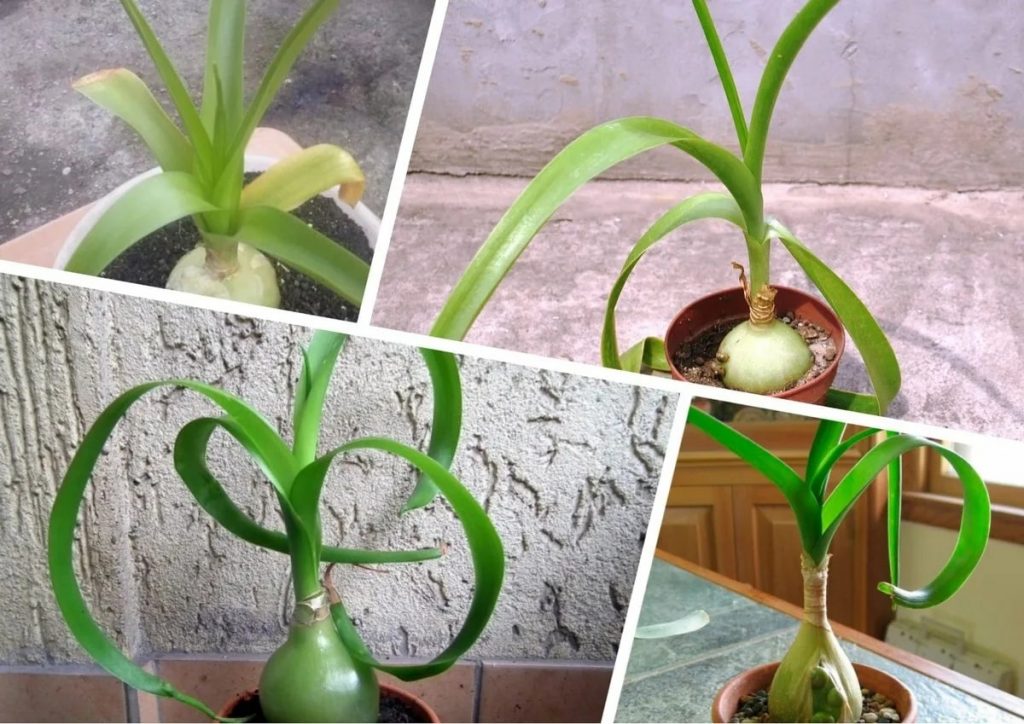
The popular nicknames of this plant are sea onion, pregnant onion, and false sea onion, which only partially helps to navigate the identification of this plant.
With botanical names, everything is much more complicated. Most flower growers are familiar with the plant as an Ornithogalum caudatum, but back in 2009 the species was officially transferred to the genus of other beautifully flowering bulbous plants and renamed Albuca bracteata, thus changing the Hyacinthaceae subfamily to Scillaceae ( Scilloideae).
This representative of the Asparagaceae family still confuses and fascinates loyal fans today.

Pregnant onion, Albuca bracteata, or Ornithogalum caudatum is a beautifully flowering bulbous perennial with a very large, smooth, up to 10 cm in length bulb, easily recognizable by the special waxy bright green coating of the smooth upper scales and a thick neck. Most of the bulbs always remain above the soil. Very thick, large roots grow from the bottom.
Plants of this species grow quite actively, forming little bulbs every year. Because of the way the seedlings grow, looking like miniature green beads – the bulbs are on the side, hidden under the upper filmy scales, which do not crack for a long time, the species is called “pregnant onions”.
The seedlings mature quickly and are easily separated, falling away from the mother’s bulb on their own. Small, almost transparent, they resemble gladiolus bulbs for some, and Rowley’s peas for others.
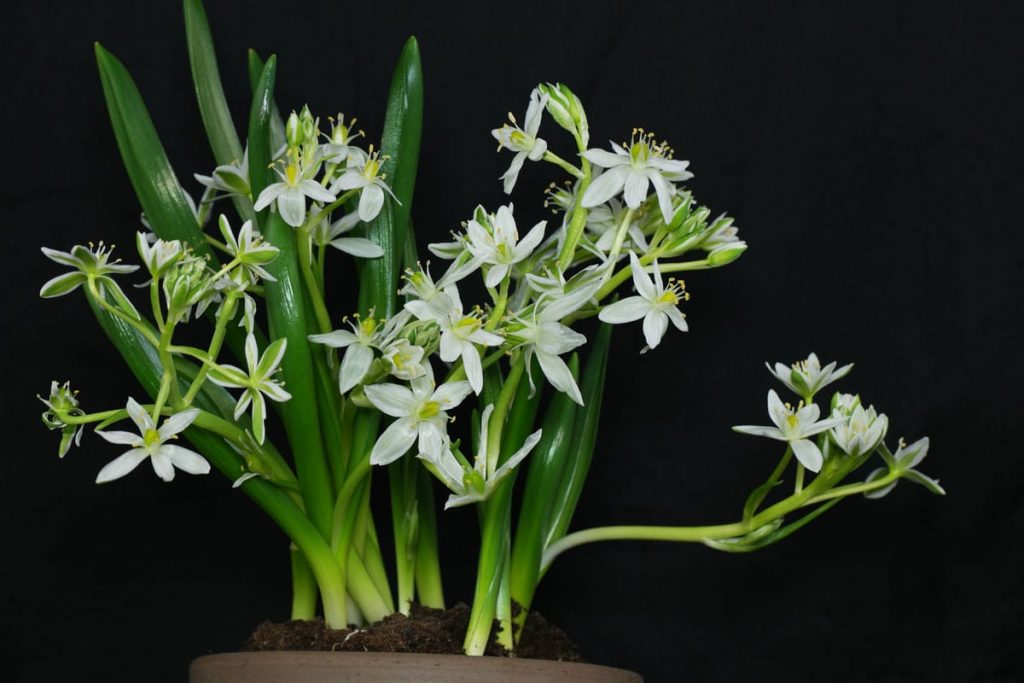
Spectacular belt-shaped semi-succulent leaves, capable of growing up to 60 m in length with a width of just over 2 cm, surprise with a juicy texture, chaotically bend and twist, taper to a pointed edge, tightly hug the flowering shoot, and are somewhat reminiscent of leek leaves.
The light green color harmonizes pleasantly with the shades of the bulb and flowers. Upon close examination, the ribs are visible on the surface of the leaves.
Flowering is for some the main advantage, but for others, it is an inconspicuous addition to the greenery of the orphanage caudate. The lime-white inflorescence appears to be an elegant bouquet but is not to everyone’s taste.
Huge raceme inflorescences in favorable conditions can grow up to 70-90 cm in height. They consist of 50-100 elegant bell-shaped flowers with a diameter of up to 5 mm. On the white background of the petals, green strokes, and veins are visible.
The light aroma of ornithischium remains one of the most complex and interesting among all bulbous plants.
The flowering period of plants usually lasts from May to August. The fruits are oval, up to 1 cm in length. The seeds are large, elongated, up to 4 mm in length.
This bulbous pregnant onion plant is toxic when taken orally, and contact with the juice can cause severe dermatitis. As a medicinal culture, it is intended for external use only.
Growing Conditions
Despite its exotic status, the pregnant onion is capable of boasting amazing adaptability. The plant adapts well to different temperatures and is generally very predictable.
Lighting and placement

The brighter the lighting, the larger the leaves, the more actively they grow and the more spectacular the ornithischium will bloom.
Direct sun burns the bulb and leaves during the midday summer, but at least 4 hours of bright sun for this bulb is a must for indoor growing. Pots with plants should be placed on the brightest window sill in the house, ideally on a south window.
In winter, without lowering the temperature, the lighting needs to be increased.
Temperature conditions and ventilation
If there is a lack of fresh air, the pregnant onion plant cannot tolerate extreme heat; it is better to limit the temperature during the active growing season to 21-25 degrees.
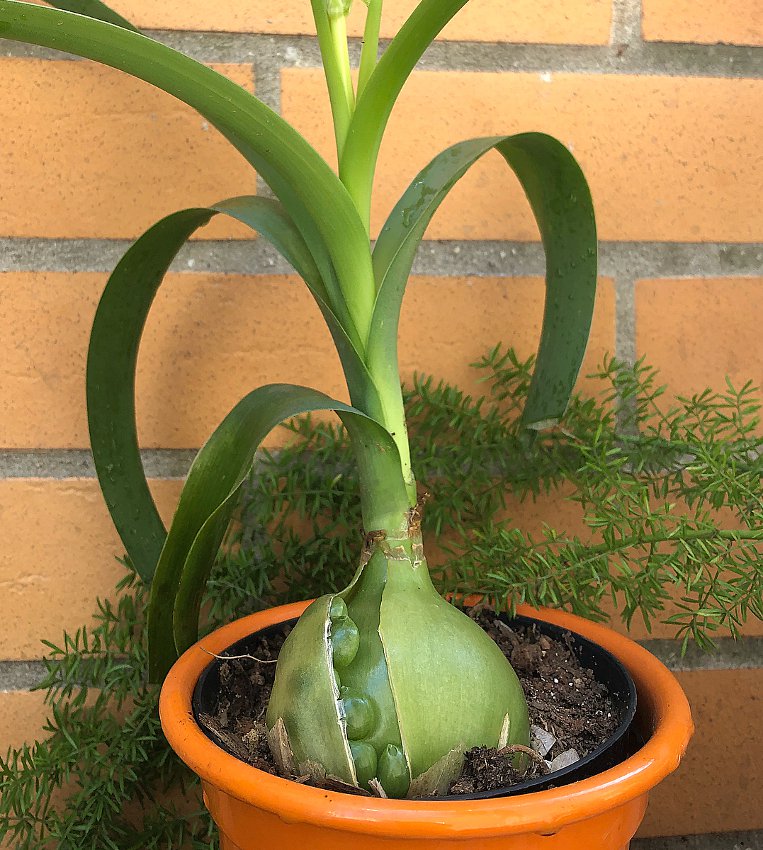
During a warm winter, the pregnant onion does not shed its leaves; only in severe lack of light does it become deformed and stretched, but never blooms. Coolness is required for flowering.
The ability to withstand frosts down to minus 5 degrees allows the plant to overwinter in the conditions that can be provided to it – from basements and a refrigerator to a cool room, from 0 to 12 degrees Celsius. The pregnant onion will not refuse to spend spring and summer on the balcony or in the garden.
Caring for The Pregnant Onion at Home
Requiring minimal care, the pregnant onion is sensitive to improper watering but often does not notice the lack of fertilizing at all.
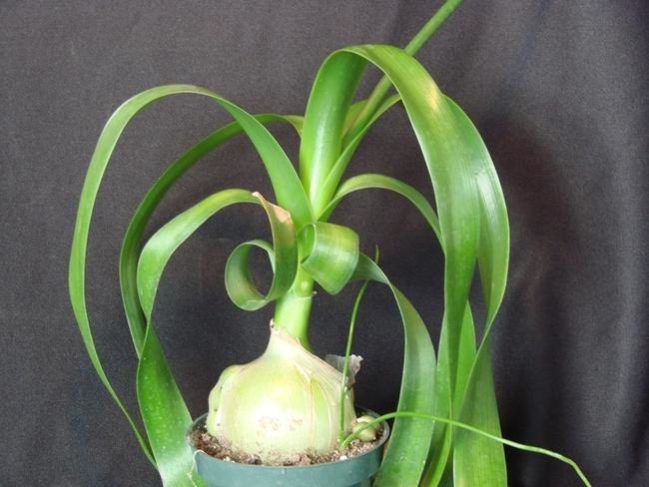
Watering and air humidity
Like all bulbous plants, the pregnant onion reacts poorly to waterlogging and dampness. Between waterings during the active growing season, you need to allow the substrate to dry out by at least 3-5 cm, preferably up to half.
Complete drying of the soil over a long period causes a transition to the dormant stage, “falling asleep.” As soon as flowering is completed, it is important to reduce watering; when moving it into cool weather, reduce it to a minimum, simply preventing the pregnant onion from losing turgor.
It is necessary to resume abundant watering in the spring carefully and gradually.
Top dressing and fertilizer

In the first year after transplantation, you don’t have to feed the pregnant onion plants at all. If there is more than one bulb in a pot, if there are signs of a lack of nutrients, and from the second year, fertilize once a month, in spring and summer, with cacti fertilizer. Only fertilizers in liquid form are acceptable.
Pruning and formation
Leaves for medicinal use are cut as desired. Yellowed and damaged leaves are removed completely, as close to the base as possible, but without damaging the neck. If desired, the “fan” can be updated by completely cutting off the leaves.
As the bulbs grow and form, the top layers of the bulb dry out. When they become completely dry and begin to peel off, they need to be removed.
Transplantation
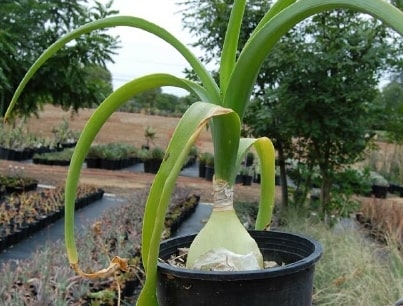
Replanting the pregnant onion is carried out in early spring, only as necessary (roots appear in the drainage holes, the substrate has become unusable, you want to change the style of the container, etc.) Pots for the pregnant onion should be compact, shallow, and selected so that there is space between the bulb and the walls of the pot about 2 cm.
You can plant several bulbs in one pot, with a distance of about 1 cm between plants. Bowls with large drainage holes are preferred. When planted in hanging baskets, the leaves create intricate cascades.
Any soil that is sufficiently air- and water-permeable is suitable for ornithischium caudate. You can use a special substrate for bulbous plants, and succulents, or simply add a portion of any baking powder to the universal soil – sand, perlite, vermiculite, etc.
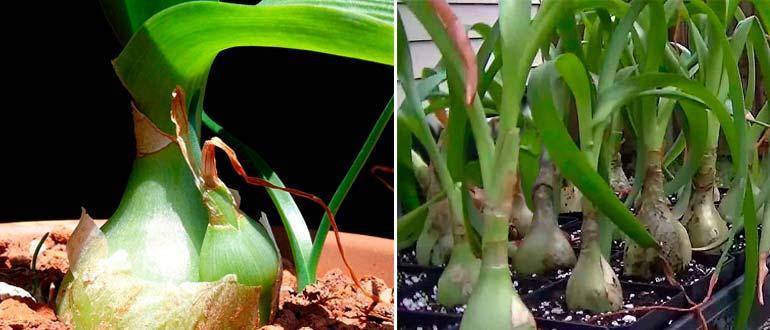
Like all bulbous plants, the pregnant onion must be grown with a high layer of drainage at the bottom of the container (from 3 cm).
The bulb of the pregnant onion plant is planted by burying no more than ⅓ of the bulb into the ground, leaving most of it on the surface, keeping track of the strict vertical position.
Deep planting is detrimental to small bulbs, but adults should not be buried even up to the neck.
Diseases and Pests
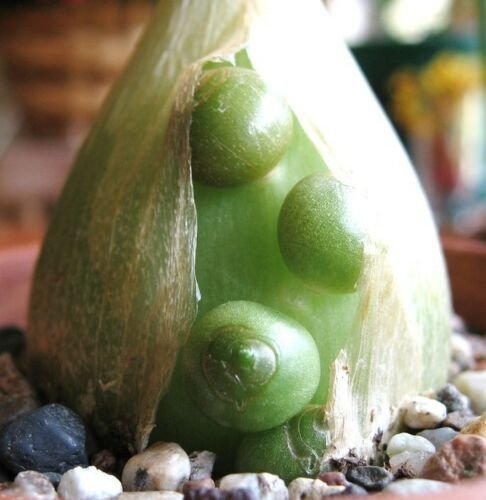
The pregnant onion not only rarely gets sick, but also repels pests from other crops. Very rarely, mealybugs are found on the poultry farm, which can be controlled by wiping with a cotton swab soaked in alcohol and systemic insecticides.
The pregnant onion is much more at risk of rotting due to dampness, which requires quick correction of errors in care, often with an emergency transplant.
Reproduction
Using little bulbs or seedlings is the best way to propagate the pregnant onion plant. If the bulbs do not fall off on their own, it is better to separate them in the spring.
Seedlings are planted, slightly deepening the base. The first watering is carried out after planting, and the second – only after the formation of the first roots. You need to be patient with this plant: first a thin “arrow” develops, and only after many months full-fledged leaves begin to appear.
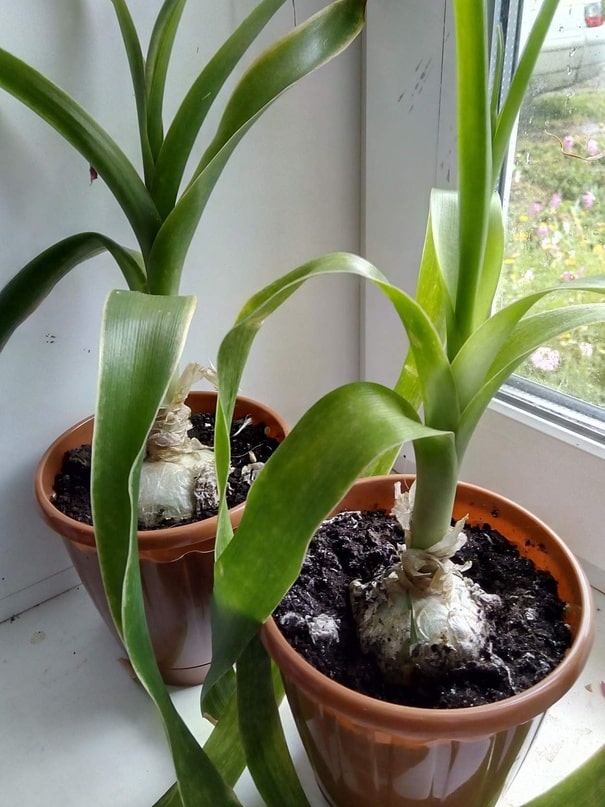
You will have to wait for flowering until the volume of the bulb reaches the same size as that of the plant from which it was obtained.
You can also grow pregnant onion plants from seeds. They are sown in a sandy substrate, superficially, grown until mini-bulbs form, and only then planted in separate pots. Seedlings bloom no earlier than 4-6 years.
Pregnant Onion Plant Benefits
While it is not commonly used for medicinal purposes in modern herbalism, it has a history of use in some traditional remedies. Here are a few potential benefits attributed to it:
- Traditional Medicinal Uses of Pregnant Onion Plant: In some cultures, the sap from the bulb is used topically for treating minor cuts, bruises, or insect bites, thanks to its possible soothing properties. It may help reduce swelling or inflammation.
- Air Purification: Like many houseplants, the pregnant onion can improve indoor air quality by removing toxins and providing oxygen.
- Aesthetic Appeal: Its unique appearance, with small bulblets that grow on the parent bulb, makes it a conversation starter and a decorative addition to homes or gardens.

